Abstract
The serum from 109 traumatized patients was examined for immunosuppressive activity which might explain diminished host immune responsiveness following operative or accidental injury. Twenty-eight fo 31 (90%) severely tralmatized patients, 25 of 60 (42%) moderately traumatized patients, and 0 of 18 minimally traumatized patients developed serum which suppressed the response of normal human lymphocytes to phytohemagglutinin. The degree and duration of serum immunosuppressive activity paralleled the severity of the clinical course but did not correlate with serum cortisol or barbiturate levels. Suppressive sera were not cytotoxic. The immunosuppressive factor(s) was contained in a low molecular weight (less than 10,000 daltons) peptide fraction and was present in 5--10 times the amount recoverable from normal serum. By size and activity the trauma serum factor resembled immunoregulatory alpha globulin, a naturally-occurring serum inhibitor of T-lymphocyte reactions. Thus, depressed immunoreactivity following trauma may be due in part to high concentrations of an endogenous immunosuppressive polypeptide.
Full text
PDF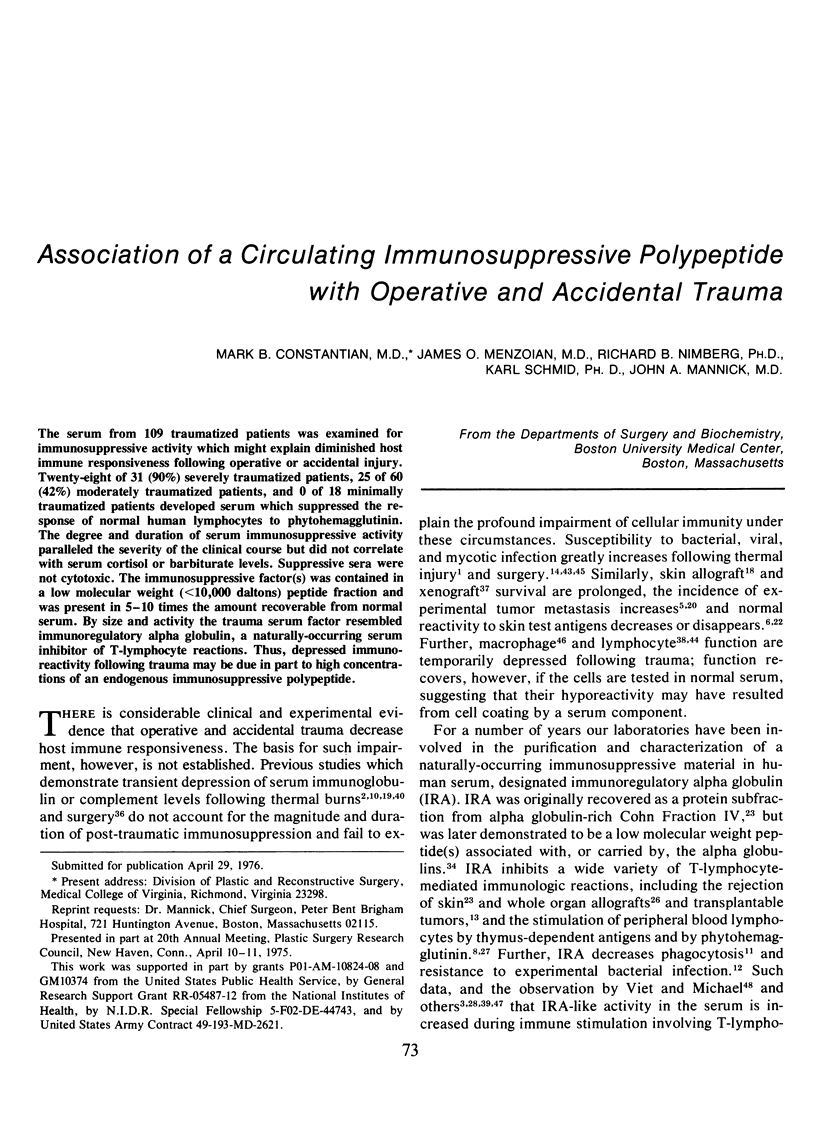
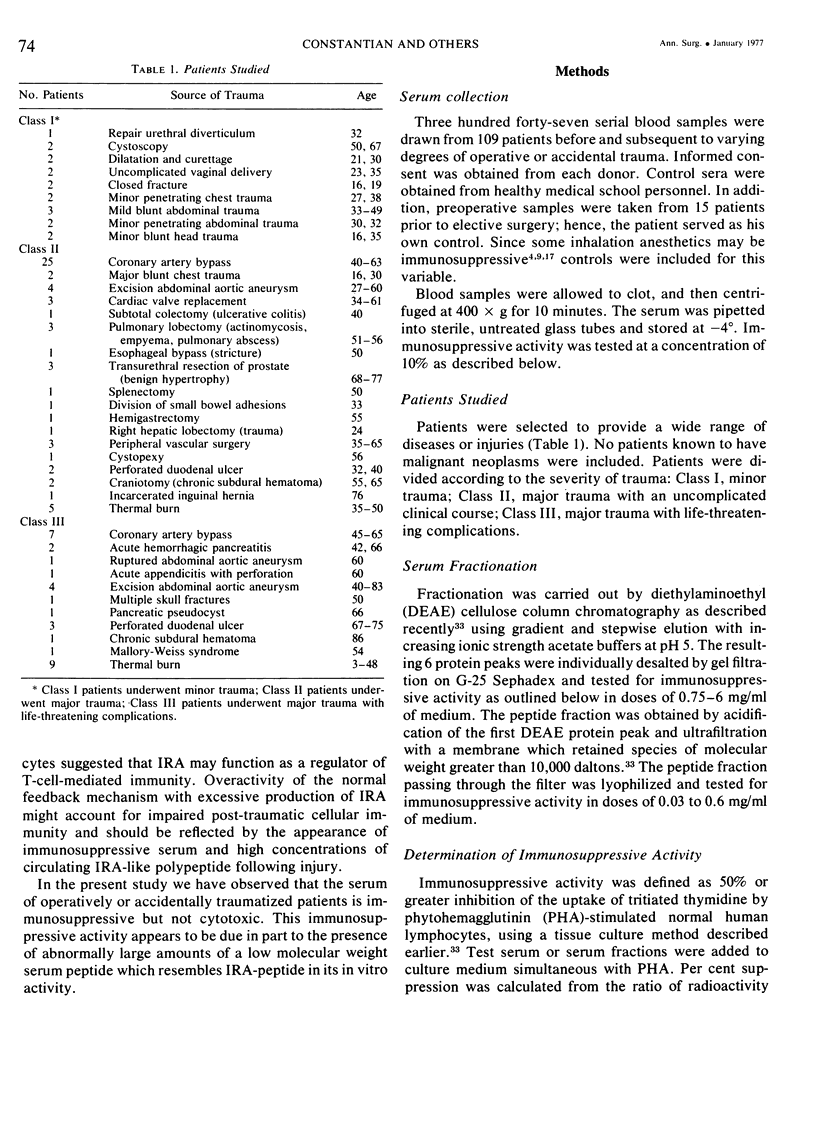
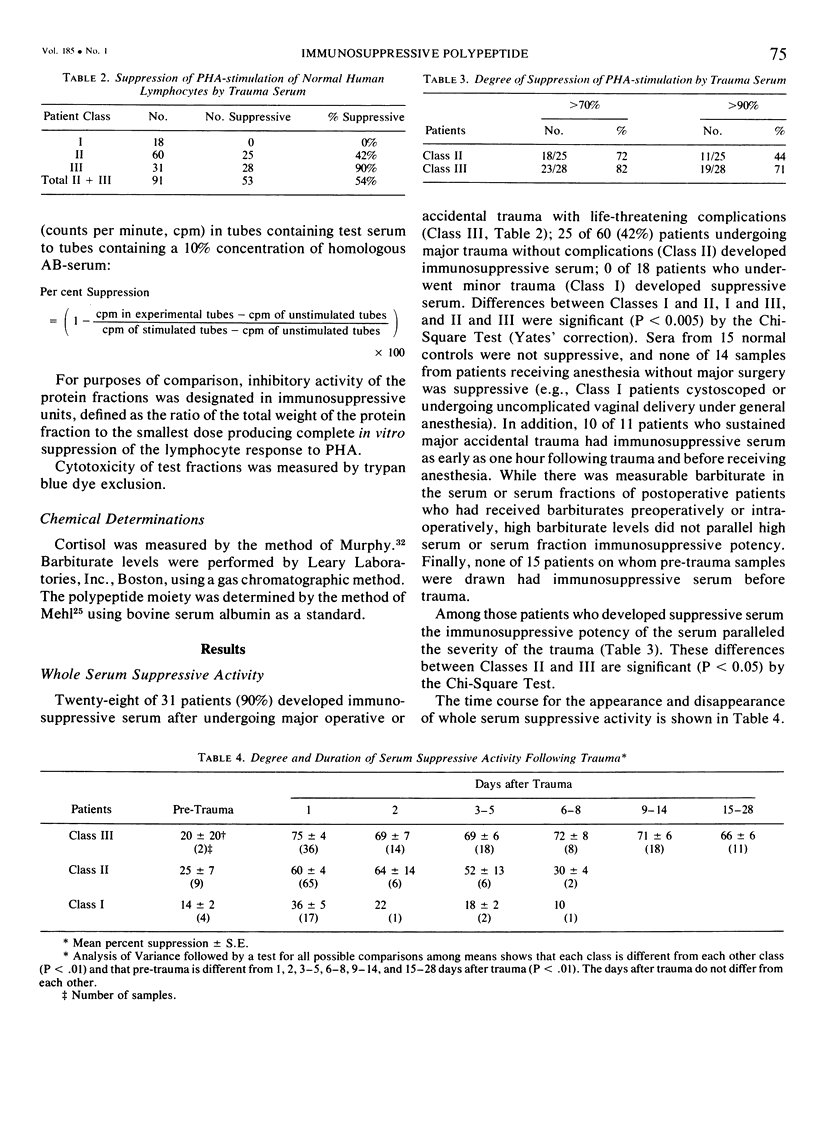
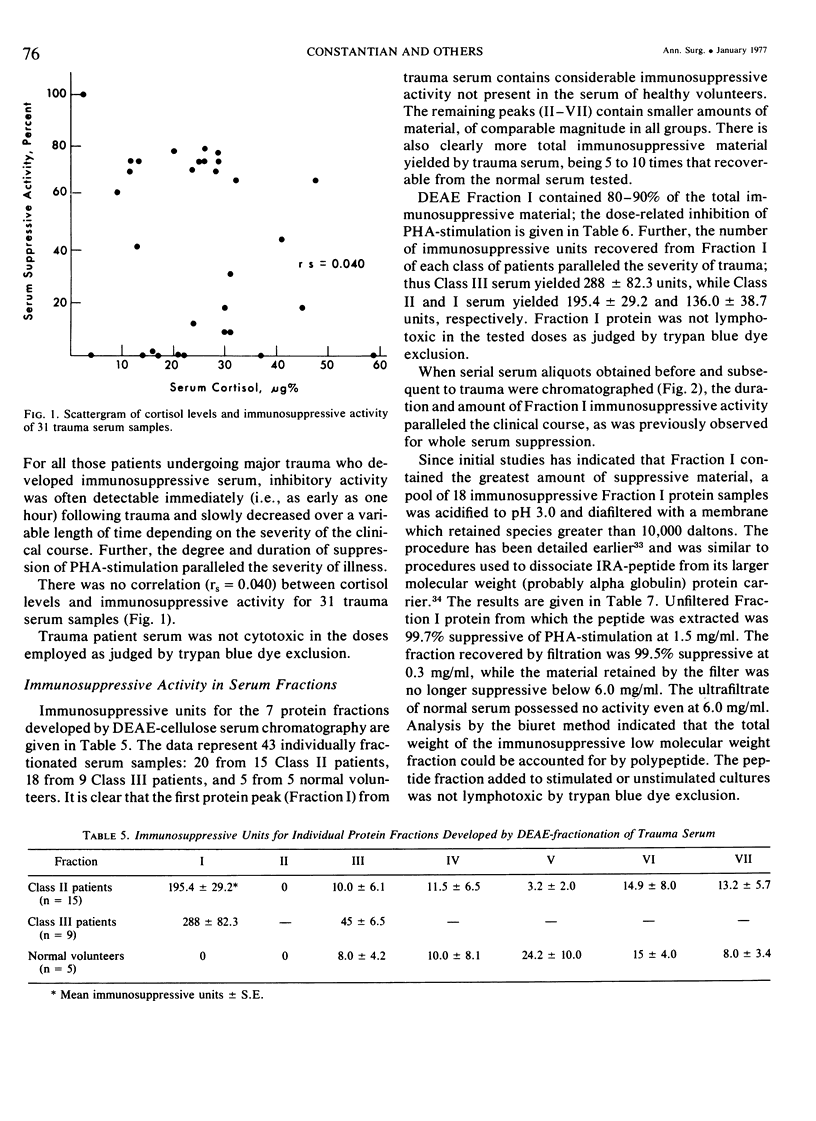
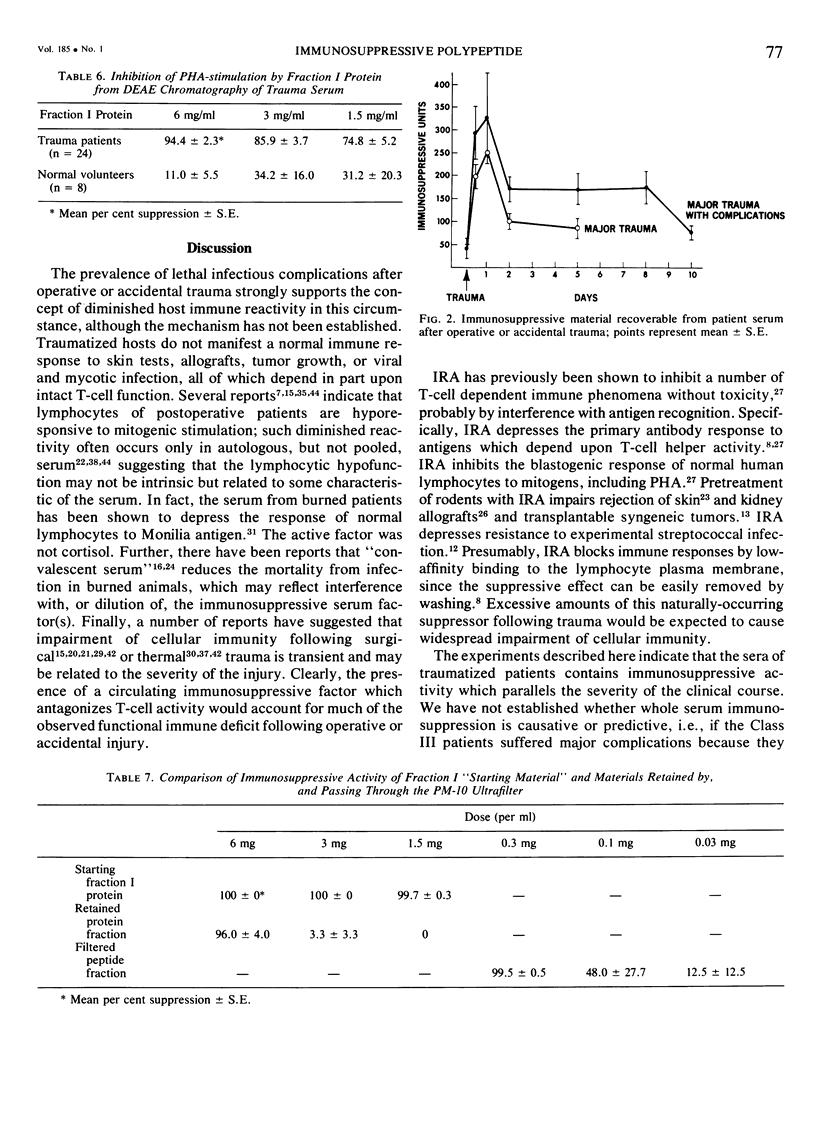
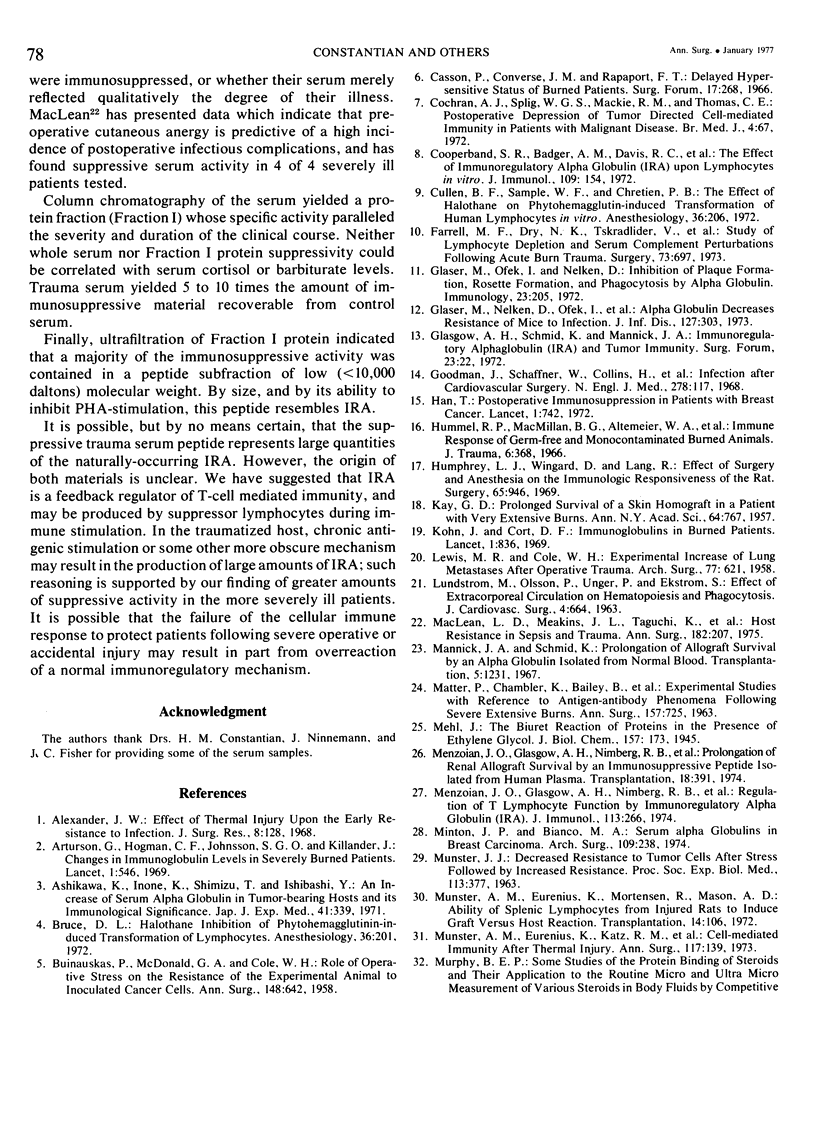
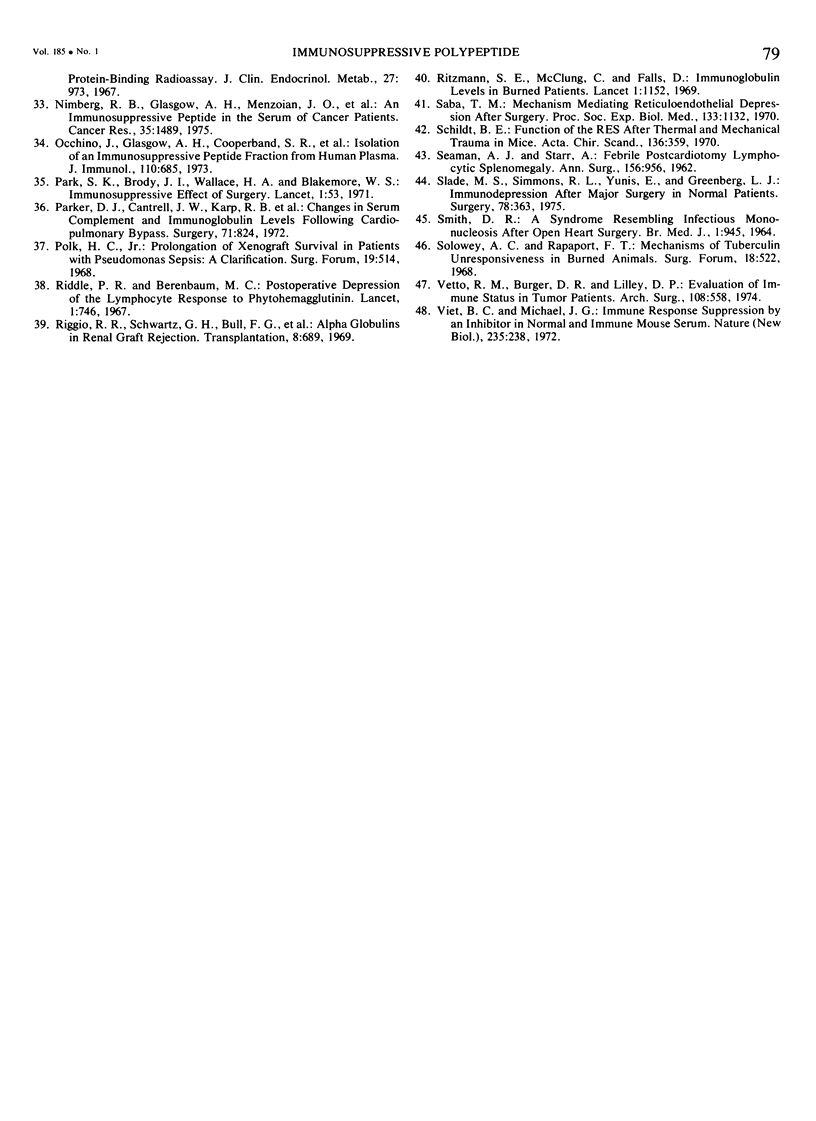
Selected References
These references are in PubMed. This may not be the complete list of references from this article.
- Alexander J. W. Effect of thermal injury upon the early resistance to infection. J Surg Res. 1968 Mar;8(3):128–137. doi: 10.1016/0022-4804(68)90074-7. [DOI] [PubMed] [Google Scholar]
- Arturson G., Högman C. F., Johansson S. G., Killander J. Changes in immunoglobulin levels in severely burned patients. Lancet. 1969 Mar 15;1(7594):546–548. doi: 10.1016/s0140-6736(69)91957-6. [DOI] [PubMed] [Google Scholar]
- Ashikawa K., Inoue K., Shimizu T., Ishibashi Y. An increase of serum alpha-globulin in tumor-bearing hosts and its immunological significance. Jpn J Exp Med. 1971 Aug;41(4):339–355. [PubMed] [Google Scholar]
- BUINAUSKAS P., McDONALD G. O., COLE W. H. Role of operative stress on the resistance of the experimental animal to inoculated cancer cells. Ann Surg. 1958 Oct;148(4):642–648. doi: 10.1097/00000658-195810000-00011. [DOI] [PMC free article] [PubMed] [Google Scholar]
- Bruce D. L. Halothane inhibition of phytohemagglutinin-induced transformation of lymphocytes. Anesthesiology. 1972 Mar;36(3):201–205. doi: 10.1097/00000542-197203000-00001. [DOI] [PubMed] [Google Scholar]
- Casson P., Solowey A. C., Converse J. M., Rapaport F. T. Delayed hypersensitivity status of burned patients. Surg Forum. 1966;17:268–270. [PubMed] [Google Scholar]
- Cochran A. J., Spilg W. G., Mackie R. M., Thomas C. E. Postoperative depression of tumour-directed cell-mediated immunity in patients with malignant disease. Br Med J. 1972 Oct 14;4(5832):67–70. [PMC free article] [PubMed] [Google Scholar]
- Cooperband S. R., Badger A. M., Davis R. C., Schmid K., Mannick J. A. The effect of immunoregulatory globulin (IRA) upon lymphocytes in vitro. J Immunol. 1972 Jul;109(1):154–163. [PubMed] [Google Scholar]
- Cullen B. F., Sample W. F., Chretien P. B. The effect of halothane on phytohemagglutinin-induced transformation of human lymphocytes in vitro. Anesthesiology. 1972 Mar;36(3):206–212. doi: 10.1097/00000542-197203000-00003. [DOI] [PubMed] [Google Scholar]
- Farrell M. F., Day N. K., Tsakraklides V., Good R. A., Day S. B. Study of lymphocyte depletion and serum complement perturbations following acute burn trauma. Surgery. 1973 May;73(5):697–705. [PubMed] [Google Scholar]
- Glaser M., Nelken D., Ofek I., Bergner-Rabinowitz S., Ginsburg I. Alpha globulin decreases resistance of mice to infection with group A Streptococcus. J Infect Dis. 1973 Mar;127(3):303–306. doi: 10.1093/infdis/127.3.303. [DOI] [PubMed] [Google Scholar]
- Glaser M., Ofek I., Nelken D. Inhibition of plaque formation, rosette formation and phagocytosis by alpha globulin. Immunology. 1972 Aug;23(2):205–214. [PMC free article] [PubMed] [Google Scholar]
- Goodman J. S., Schaffner W., Collins H. A., Battersby E. J., Koenig M. G. Infection after cardiovascular surgery. Clinical study including examination of antimicrobial prophylaxis. N Engl J Med. 1968 Jan 18;278(3):117–123. doi: 10.1056/NEJM196801182780301. [DOI] [PubMed] [Google Scholar]
- Han T. Postoperative immunosuppression in patients with breast cancer. Lancet. 1972 Apr 1;1(7753):742–743. doi: 10.1016/s0140-6736(72)90248-6. [DOI] [PubMed] [Google Scholar]
- Hummel R. P., MacMillan B. G., Altemeier W. A., Hill E. O. Immune response of germ-free and monocontaminated burned animals. J Trauma. 1966 May;6(3):368–390. [PubMed] [Google Scholar]
- Humphrey L. J., Wingard D. W., Lang R. The effects of surgery and anesthesia on the immunologic responsiveness of the rat. Surgery. 1969 Jun;65(6):946–951. [PubMed] [Google Scholar]
- KAY G. D. Prolonged survival of a skin homograft in a patient with very extensive burns. Ann N Y Acad Sci. 1957 Mar 22;64(5):767–774. doi: 10.1111/j.1749-6632.1957.tb52471.x. [DOI] [PubMed] [Google Scholar]
- Kohn J., Cort D. F. Immunoglobulins in burned patients. Lancet. 1969 Apr 19;1(7599):836–837. doi: 10.1016/s0140-6736(69)92092-3. [DOI] [PubMed] [Google Scholar]
- LEWIS M. R., COLE W. H. Experimental increase of lung metastases after operative trauma (amputation of limb with tumor). AMA Arch Surg. 1958 Oct;77(4):621–626. doi: 10.1001/archsurg.1958.04370010153015. [DOI] [PubMed] [Google Scholar]
- LUNDSTROEM M., OLSSON P., UNGER P., EKESTROEM S. EFFECT OF EXTRACORPOREAL CIRCULATION ON HEMATOPOIESIS AND PHAGOCYTOSIS. J Cardiovasc Surg (Torino) 1963 Aug;4:664–668. [PubMed] [Google Scholar]
- MATTER P., CHAMBLER K., BAILEY B., LEWIS S. R., BLOCKER T. G., Jr, BLOCKER V. Experimental studies with reference to antigen-antibody phenomena following severe extensive burns. Ann Surg. 1963 May;157:725–736. doi: 10.1097/00000658-196305000-00007. [DOI] [PMC free article] [PubMed] [Google Scholar]
- MacLean L. D., Meakins J. L., Taguchi K., Duignan J. P., Dhillon K. S., Gordon J. Host resistance in sepsis and trauma. Ann Surg. 1975 Sep;182(3):207–217. doi: 10.1097/00000658-197509000-00004. [DOI] [PMC free article] [PubMed] [Google Scholar]
- Mannick J. A., Schmid K. Prolongation of allograft survival by an alpha globulin isolated from normal blood. Transplantation. 1967 Jul;5(4 Suppl):1231–1238. doi: 10.1097/00007890-196707001-00063. [DOI] [PubMed] [Google Scholar]
- Menzoian J. O., Glasgow A. H., Nimberg R. B., Constantian M. B., Stevens R. L., Cooperband S. R., Schmid K., Mannick J. A. The prolongation of renal allograft survival by an immunosuppressive peptide isolated from human plasma. Transplantation. 1974 Nov;18(5):391–394. doi: 10.1097/00007890-197411000-00002. [DOI] [PubMed] [Google Scholar]
- Menzoian J. O., Glasgow A. H., Nimberg R. D., Cooperband S. R., Schmid K., Saporoschetz I., Mannick J. A. Regulation of T lymphocyte function by immunoregulatory alphaglobulin (IRA). J Immunol. 1974 Jul;113(1):266–273. [PubMed] [Google Scholar]
- Minton J. P., Bianco M. A. Serum alpha2-globulins in breast carcinoma. Arch Surg. 1974 Aug;109(2):238–240. doi: 10.1001/archsurg.1974.01360020100019. [DOI] [PubMed] [Google Scholar]
- Modafferi T. R., Rosen H., Chandler J. G., Orloff M. J. The role of the renin-angiotensin system in the aldosterone response to acute hemorrhage. Surg Forum. 1972;23(0):22–23. [PubMed] [Google Scholar]
- Munster A. M., Eurenius K., Katz R. M., Canales L., Foley F. D., Mortensen R. F. Cell-mediated immunity after thermal injury. Ann Surg. 1973 Feb;177(2):139–143. doi: 10.1097/00000658-197302000-00002. [DOI] [PMC free article] [PubMed] [Google Scholar]
- Munster A. M., Eurenius K., Mortensen R. F., Mason A. D., Jr Ability of splenic lymphocytes from injured rats to induce a graft-versus-host reaction. Transplantation. 1972 Jul;14(1):106–108. doi: 10.1097/00007890-197207000-00015. [DOI] [PubMed] [Google Scholar]
- Murphy B. E. Some studies of the protein-binding of steroids and their application to the routine micro and ultramicro measurement of various steroids in body fluids by competitive protein-binding radioassay. J Clin Endocrinol Metab. 1967 Jul;27(7):973–990. doi: 10.1210/jcem-27-7-973. [DOI] [PubMed] [Google Scholar]
- Nimberg R. B., Glasgow A. H., Menzoian J. O., Constantian M. B., Cooperband S. R., Mannick J. A., Schmid K. Isolation of an immunosuppressive peptide fraction from the serum of cancer patients. Cancer Res. 1975 Jun;35(6):1489–1494. [PubMed] [Google Scholar]
- Occhino J. C., Glasgow A. H., Cooperband S. R., Mannick J. A., Schmid K. Isolation of an immunosuppressive peptide fraction from human plasma. J Immunol. 1973 Mar;110(3):685–694. [PubMed] [Google Scholar]
- Park S. K., Brody J. I., Wallace H. A., Blakemore W. S. Immunosuppressive effect of surgery. Lancet. 1971 Jan 9;1(7689):53–55. doi: 10.1016/s0140-6736(71)90777-x. [DOI] [PubMed] [Google Scholar]
- Parker D. J., Cantrell J. W., Karp R. B., Stroud R. M., Digerness S. B. Changes in serum complement and immunoglobulins following cardiopulmonary bypass. Surgery. 1972 Jun;71(6):824–827. [PubMed] [Google Scholar]
- Riddle P. R., Berenbaum M. C. Postoperative depression of the lymphocyte response to phytohaemagglutinin. Lancet. 1967 Apr 8;1(7493):746–748. doi: 10.1016/s0140-6736(67)91364-5. [DOI] [PubMed] [Google Scholar]
- Riggio R. R., Schwartz G. H., Bull F. G., Stenzel K. H., Rubin A. L. Alpha-2-globulins in renal graft rejection. Effects of in vitro lymphocyte function. Transplantation. 1969 Nov;8(5):689–694. doi: 10.1097/00007890-196911000-00013. [DOI] [PubMed] [Google Scholar]
- Ritzmann S. E., Larson D. L., McClung C., Abston S., Falls D., Goldman A. S. Immunoglobulin levels in burned patients. Lancet. 1969 Jun 7;1(7606):1152–1153. doi: 10.1016/s0140-6736(69)91670-5. [DOI] [PubMed] [Google Scholar]
- SEAMAN A. J., STARR A. Febrile postcardiotomy lymphocytic splenomegaly: a new entity. Ann Surg. 1962 Dec;156:956–960. doi: 10.1097/00000658-196212000-00014. [DOI] [PMC free article] [PubMed] [Google Scholar]
- SMITH D. R. A SYNDROME RESEMBLING INFECTIOUS MONONUCLEOSIS AFTER OPEN-HEART SURGERY. Br Med J. 1964 Apr 11;1(5388):945–948. doi: 10.1136/bmj.1.5388.945. [DOI] [PMC free article] [PubMed] [Google Scholar]
- Saba T. M. Mechanism mediating reticuloendothelial system depression after surgery. Proc Soc Exp Biol Med. 1970 Apr;133(4):1132–1136. doi: 10.3181/00379727-133-34638. [DOI] [PubMed] [Google Scholar]
- Schildt B. E. Function of the RES after thermal and mechanical trauma in mice. Acta Chir Scand. 1970;136(5):359–364. [PubMed] [Google Scholar]
- Slade M. S., Simmons R. L., Yunis E., Greenberg L. J. Immunodepression after major surgery in normal patients. Surgery. 1975 Sep;78(3):363–372. [PubMed] [Google Scholar]
- Veit B. C., Michael J. G. Immune response suppression by an inhibitor in normal and immune mouse serum. Nat New Biol. 1972 Feb 23;235(60):238–240. doi: 10.1038/newbio235238a0. [DOI] [PubMed] [Google Scholar]
- Vetto R. M., Burger D. R., Lilley D. P. Proceedings: Evaluation of immune status in tumor patients. Arch Surg. 1974 Apr;108(4):558–560. doi: 10.1001/archsurg.1974.01350280160026. [DOI] [PubMed] [Google Scholar]


